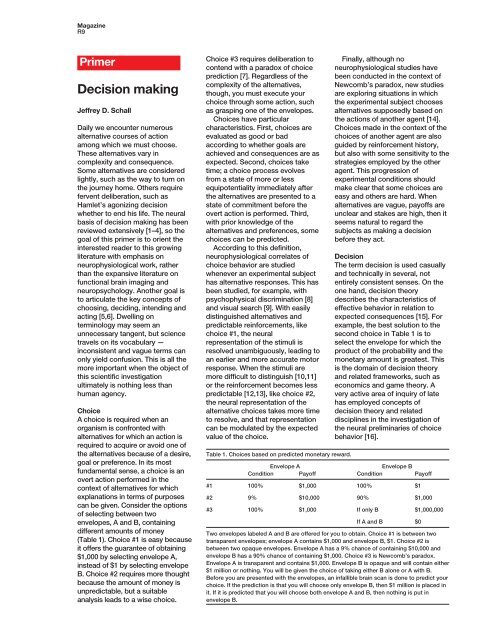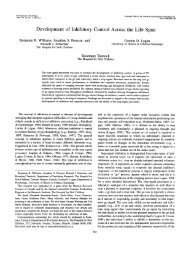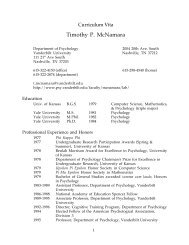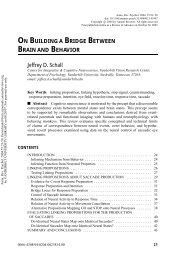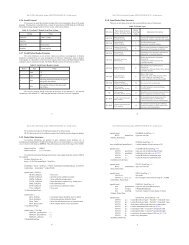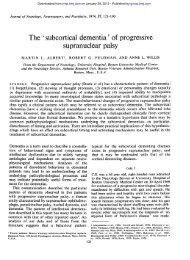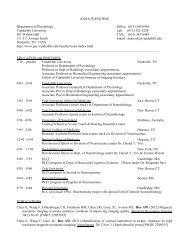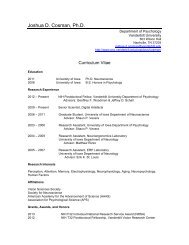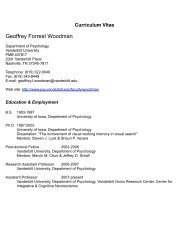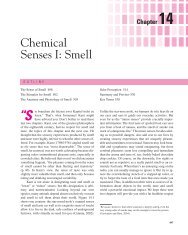Decision making - Vanderbilt University
Decision making - Vanderbilt University
Decision making - Vanderbilt University
Create successful ePaper yourself
Turn your PDF publications into a flip-book with our unique Google optimized e-Paper software.
Magazine<br />
R9<br />
Primer<br />
<strong>Decision</strong> <strong>making</strong><br />
Jeffrey D. Schall<br />
Daily we encounter numerous<br />
alternative courses of action<br />
among which we must choose.<br />
These alternatives vary in<br />
complexity and consequence.<br />
Some alternatives are considered<br />
lightly, such as the way to turn on<br />
the journey home. Others require<br />
fervent deliberation, such as<br />
Hamlet’s agonizing decision<br />
whether to end his life. The neural<br />
basis of decision <strong>making</strong> has been<br />
reviewed extensively [1–4], so the<br />
goal of this primer is to orient the<br />
interested reader to this growing<br />
literature with emphasis on<br />
neurophysiological work, rather<br />
than the expansive literature on<br />
functional brain imaging and<br />
neuropsychology. Another goal is<br />
to articulate the key concepts of<br />
choosing, deciding, intending and<br />
acting [5,6]. Dwelling on<br />
terminology may seem an<br />
unnecessary tangent, but science<br />
travels on its vocabulary —<br />
inconsistent and vague terms can<br />
only yield confusion. This is all the<br />
more important when the object of<br />
this scientific investigation<br />
ultimately is nothing less than<br />
human agency.<br />
Choice<br />
A choice is required when an<br />
organism is confronted with<br />
alternatives for which an action is<br />
required to acquire or avoid one of<br />
the alternatives because of a desire,<br />
goal or preference. In its most<br />
fundamental sense, a choice is an<br />
overt action performed in the<br />
context of alternatives for which<br />
explanations in terms of purposes<br />
can be given. Consider the options<br />
of selecting between two<br />
envelopes, A and B, containing<br />
different amounts of money<br />
(Table 1). Choice #1 is easy because<br />
it offers the guarantee of obtaining<br />
$1,000 by selecting envelope A,<br />
instead of $1 by selecting envelope<br />
B. Choice #2 requires more thought<br />
because the amount of money is<br />
unpredictable, but a suitable<br />
analysis leads to a wise choice.<br />
Choice #3 requires deliberation to<br />
contend with a paradox of choice<br />
prediction [7]. Regardless of the<br />
complexity of the alternatives,<br />
though, you must execute your<br />
choice through some action, such<br />
as grasping one of the envelopes.<br />
Choices have particular<br />
characteristics. First, choices are<br />
evaluated as good or bad<br />
according to whether goals are<br />
achieved and consequences are as<br />
expected. Second, choices take<br />
time; a choice process evolves<br />
from a state of more or less<br />
equipotentiality immediately after<br />
the alternatives are presented to a<br />
state of commitment before the<br />
overt action is performed. Third,<br />
with prior knowledge of the<br />
alternatives and preferences, some<br />
choices can be predicted.<br />
According to this definition,<br />
neurophysiological correlates of<br />
choice behavior are studied<br />
whenever an experimental subject<br />
has alternative responses. This has<br />
been studied, for example, with<br />
psychophysical discrimination [8]<br />
and visual search [9]. With easily<br />
distinguished alternatives and<br />
predictable reinforcements, like<br />
choice #1, the neural<br />
representation of the stimuli is<br />
resolved unambiguously, leading to<br />
an earlier and more accurate motor<br />
response. When the stimuli are<br />
more difficult to distinguish [10,11]<br />
or the reinforcement becomes less<br />
predictable [12,13], like choice #2,<br />
the neural representation of the<br />
alternative choices takes more time<br />
to resolve, and that representation<br />
can be modulated by the expected<br />
value of the choice.<br />
Table 1. Choices based on predicted monetary reward.<br />
Finally, although no<br />
neurophysiological studies have<br />
been conducted in the context of<br />
Newcomb’s paradox, new studies<br />
are exploring situations in which<br />
the experimental subject chooses<br />
alternatives supposedly based on<br />
the actions of another agent [14].<br />
Choices made in the context of the<br />
choices of another agent are also<br />
guided by reinforcement history,<br />
but also with some sensitivity to the<br />
strategies employed by the other<br />
agent. This progression of<br />
experimental conditions should<br />
make clear that some choices are<br />
easy and others are hard. When<br />
alternatives are vague, payoffs are<br />
unclear and stakes are high, then it<br />
seems natural to regard the<br />
subjects as <strong>making</strong> a decision<br />
before they act.<br />
<strong>Decision</strong><br />
The term decision is used casually<br />
and technically in several, not<br />
entirely consistent senses. On the<br />
one hand, decision theory<br />
describes the characteristics of<br />
effective behavior in relation to<br />
expected consequences [15]. For<br />
example, the best solution to the<br />
second choice in Table 1 is to<br />
select the envelope for which the<br />
product of the probability and the<br />
monetary amount is greatest. This<br />
is the domain of decision theory<br />
and related frameworks, such as<br />
economics and game theory. A<br />
very active area of inquiry of late<br />
has employed concepts of<br />
decision theory and related<br />
disciplines in the investigation of<br />
the neural preliminaries of choice<br />
behavior [16].<br />
Envelope A<br />
Envelope B<br />
Condition Payoff Condition Payoff<br />
#1 100% $1,000 100% $1<br />
#2 9% $10,000 90% $1,000<br />
#3 100% $1,000 If only B $1,000,000<br />
If A and B $0<br />
Two envelopes labeled A and B are offered for you to obtain. Choice #1 is between two<br />
transparent envelopes; envelope A contains $1,000 and envelope B, $1. Choice #2 is<br />
between two opaque envelopes. Envelope A has a 9% chance of containing $10,000 and<br />
envelope B has a 90% chance of containing $1,000. Choice #3 is Newcomb’s paradox.<br />
Envelope A is transparent and contains $1,000. Envelope B is opaque and will contain either<br />
$1 million or nothing. You will be given the choice of taking either B alone or A with B.<br />
Before you are presented with the envelopes, an infallible brain scan is done to predict your<br />
choice. If the prediction is that you will choose only envelope B, then $1 million is placed in<br />
it. If it is predicted that you will choose both envelope A and B, then nothing is put in<br />
envelope B.
Current Biology Vol 15 No 1<br />
R10<br />
On the other hand, we can refer<br />
to a decision as a process that<br />
results in the overt act of choosing.<br />
Such a process must have a<br />
particular architecture, but<br />
measures of outcome derived from<br />
decision theory do not uniquely<br />
specify mechanism. <strong>Decision</strong> as a<br />
process has two logically and<br />
practically distinct meanings. We<br />
must distinguish between decide<br />
to, which is a selection between<br />
alternative actions, and decide<br />
that, which is a selection between<br />
alternative categories of an image<br />
or concept. The logical distinction<br />
is easy to see. You can decide that<br />
falsely, but you cannot decide to<br />
falsely — it is not intelligible. The<br />
decision that envelope B always<br />
contained $1 million is false, but in<br />
what sense can you decide falsely<br />
to take envelope B? You just take it<br />
or you do not. Decide to, like<br />
choosing, is judged as good or<br />
bad, but not as true or false.<br />
The fact that choices can be<br />
predicted makes it possible to<br />
choose in advance: it is intelligible<br />
to say, “I will choose envelope B<br />
when given the opportunity.” This<br />
sense of choice is more related to<br />
decision. But important<br />
distinctions must be recognized<br />
between ‘choose’ and ‘decide to’.<br />
Whereas ‘choice’ refers most<br />
directly to the final commitment to<br />
one among the alternative actions,<br />
‘decision’ refers most directly to<br />
the deliberation preceding the<br />
action. Deliberation involves<br />
weighing the options which<br />
amounts to contrasting the<br />
characteristics of the alternatives<br />
in working memory. Such<br />
deliberation is rarely (if ever) only<br />
rational, for emotional valence<br />
influences decisions too [17].<br />
The polarity of deciding and<br />
choosing can be highlighted by<br />
contrasting the three choices in<br />
Table 1. For any of the three, you<br />
must enact a choice by grasping<br />
an envelope (you could just point<br />
or speak to choose through<br />
symbolic actions, but some<br />
movement must occur). But it is<br />
likely that, before you can make<br />
choices #2 or #3, you must invest<br />
more effort to comprehend the<br />
alternatives, understand the<br />
differences between them and<br />
identify which would be most<br />
satisfying. The course of this<br />
deliberation reveals another<br />
defining feature of decisions that<br />
distinguishes them from choices:<br />
decisions cannot be predicted,<br />
even by the agent. If you can say<br />
what you will decide, then you will<br />
have decided.<br />
In other words, decisions, like<br />
perceptions, just happen;<br />
introspection cannot find the<br />
source of a decision [18]. By<br />
monitoring the activity of the<br />
neurons that produce the decision<br />
as described above, however, it<br />
becomes possible to predict the<br />
choice. Morever, it is also possible<br />
to manipulate decisions by<br />
electrical stimulation [19]. But this<br />
ability to predict and manipulate<br />
choices has strict limits; most<br />
fundamentally, it requires proper<br />
experimental control of numerous<br />
extraneous variables. Thus, while it<br />
is appropriate to contemplate the<br />
ethical and legal ramifications of<br />
this technical breakthrough [20],<br />
the social fabric is unlikely to be<br />
torn by it very soon.<br />
Choice #3 provides a useful<br />
domain in which to clarify further<br />
these ideas. It is based on the<br />
premise that a person’s choice can<br />
be predicted reliably (by a brain<br />
scan perhaps). The rules of this<br />
choice are explained in Table 1.<br />
Imagine that you have observed<br />
others make this choice and that<br />
every time they took only envelope<br />
B, it contained $1 million; and<br />
every time they took both,<br />
envelope B was empty. Would you<br />
reason that the choice prediction is<br />
reliable and so choose only<br />
envelope B to become a<br />
millionaire? Or would you reason<br />
that, once the prediction was made<br />
and you are presented with the<br />
selection, the contents of the<br />
envelopes will not change, and so<br />
choose both envelopes so as not<br />
to forego the obvious $1,000? Both<br />
arguments seem sound, but they<br />
cannot both be correct, so which is<br />
wrong? Your reaction to the<br />
contents of the envelopes opened<br />
after <strong>making</strong> choice 3 may be<br />
pleasure or distress, according to<br />
whether the outcome was<br />
consistent with your intention.<br />
What did you mean to do?<br />
Intention<br />
The term intention is complex [21].<br />
The disposition to perform some<br />
act is a central feature of an<br />
intention, but intention cannot be<br />
identified entirely with response<br />
preparation. A statement of<br />
intention must also answer “why<br />
was that done?”. Of course, one<br />
answer might be the causal path<br />
through neurons to muscles, but<br />
this is incomplete. A satisfactory<br />
explanation must address the<br />
reasons for the action based on<br />
preferences, goals and beliefs. In<br />
other words, to judge whether a<br />
movement was intended, one must<br />
refer to the agent’s beliefs about<br />
which action must be performed<br />
under what circumstances to bring<br />
about the desired object of the<br />
intention. A consequence of this is<br />
that intentions may not be realized;<br />
success can be judged only with<br />
reference to the description of the<br />
goal and the conditions under<br />
which it could be achieved [22].<br />
Furthermore, a particular<br />
movement may be intentional<br />
under one description but not<br />
under another; for example, an eye<br />
may wink or blink. The<br />
neurophysiology literature has<br />
used the term intention to refer<br />
only to response preparation [23].<br />
Until nonhuman primates can<br />
report what they meant to do, the<br />
scientific study of intentionality<br />
may be restricted to humans [24].<br />
Action<br />
The term action has been used<br />
above, but it is a complex concept<br />
[25]. Often one does one thing<br />
(obtain money) by doing something<br />
else (pick up an envelope). But all<br />
such descriptions of actions<br />
reduce to a basic action that we<br />
perform without any preliminaries,<br />
such as moving a hand (to grasp<br />
an envelope to obtain money). We<br />
cannot say how we move our<br />
hand; it just happens when we will<br />
it. The neurophysiological basis of<br />
producing basic actions such as<br />
gaze shifts and reaching are<br />
reasonably well understood [26].<br />
Defining a body movement as an<br />
action depends on context. A<br />
purposeful action (a wink) is<br />
distinguished from a mere event (a<br />
blink) by reference to some<br />
intelligible plan, because actions<br />
are performed to achieve a goal. In<br />
other words, actions have reasons<br />
(“I did it for...”), but events just<br />
have causes (“It happened
Magazine<br />
R11<br />
because...”). Reasons for actions<br />
are explanations in terms of<br />
purposes, that is, intentions. Thus,<br />
a particular movement may be<br />
intentional under one description<br />
but not under another. With human<br />
subjects it is possible to<br />
distinguish the brain states<br />
producing intentional versus<br />
unintentional movements [27,28].<br />
But if all actions are caused by<br />
neurons firing and muscles<br />
contracting, how can there be any<br />
reasons for actions? Evidence for<br />
many-to-one mapping of brain<br />
states onto movements has<br />
important implications for<br />
elucidating a neural basis of<br />
intentional action [29]. If the<br />
mapping of neural activity onto<br />
movement were one-to-one, the<br />
causal basis of movements would<br />
be clear: a particular action follows<br />
necessarily from a given brain<br />
state as reliably as a reflex. While<br />
such an automatic causal process<br />
seems an adequate account of<br />
certain kinds of movements (such<br />
as blinks), it cannot provide a<br />
satisfactory account of other kinds<br />
(such as winks). Intended<br />
movements are owned (“I did”)<br />
while unintended movements are<br />
not (“it happened”). In other words,<br />
we distinguish the cause of from<br />
the reason for movements [30].<br />
In fact, some have argued that a<br />
many-to-one mapping of neural<br />
activity onto cognition and<br />
behavior provides room for<br />
intentional reasons within neural<br />
causes [31]. If a given basic action<br />
can arise from different brain<br />
states, then the dependence of the<br />
behavior on an intention can hold<br />
in virtue of the content of the<br />
representation of the intention and<br />
not its neural realization, that is,<br />
the content which answers “why<br />
did you do that?”. Thus, a<br />
movement can be called an<br />
intentional action if and only if it<br />
originates from a cognitive state<br />
with meaningful content, and this<br />
content defines the cognitive<br />
state’s causal influence.<br />
This analysis depends on<br />
whether the brain knows what it<br />
means to do. Recent research has<br />
shown that the medial frontal lobe<br />
registers error and success [32].<br />
For example, in monkeys<br />
performing a task requiring the<br />
interruption of a planned action,<br />
neurons signaling errors and<br />
omission of earned reinforcement<br />
were observed in the medial frontal<br />
lobe [33]. Such signals can be<br />
used to adjust behavior and<br />
provide the basis for distinguishing<br />
“I did” from “it happened”.<br />
References<br />
1. Schall, J.D. (2001). Neural basis of<br />
deciding, choosing and acting. Nat.<br />
Rev. Neurosci. 2, 33–42.<br />
2. Glimcher, P.W. (2001). Making<br />
choices: the neurophysiology of<br />
visual-saccadic decision <strong>making</strong>.<br />
Trends Neurosci. 24, 654–659.<br />
3. Romo, R., and Salinas, E. (2001).<br />
Touch and go: decision-<strong>making</strong><br />
mechanisms in somatosensation.<br />
Annu. Rev. Neurosci. 24, 107–137.<br />
4. Gold, J.I., and Shadlen, M.N. (2001).<br />
Neural computations that underlie<br />
decisions about sensory stimuli.<br />
Trends Cogn. Sci. 5, 10–16.<br />
5. Nowell-Smith, P.H. (1958).<br />
Choosing, deciding and doing.<br />
Analysis 18, 63–69.<br />
6. Evans, L.L. (1955). Choice.<br />
Philosophy Qtr. 5, 303–315.<br />
7. Nozick, R. (1969). Newcomb's<br />
problem and two principles of<br />
choice. In Essays in Honor of Carl G.<br />
Hempl and N. Rescher, eds.<br />
(Holland, Dordrecht: D. Reidel).<br />
8. Parker, A.J., and Newsome, W.T.<br />
(1998). Sense and the single neuron:<br />
probing the physiology of<br />
perception. Annu. Rev. Neurosci. 21,<br />
227–277.<br />
9. Schall, J.D. (2002). The neural<br />
selection and control of saccades<br />
by the frontal eye field. Philos.<br />
Trans. R. Soc. Lond. B Biol. Sci.<br />
357, pp1073–1082.<br />
10. Sato, T., and Murthy, A. (2001). K.G.,<br />
Thompson, J.D. Schall. Search<br />
efficiency but not response<br />
interference affects visual selection<br />
in frontal eye field. Neuron 30,<br />
583–591.<br />
11. Roitman, J.D., and Shadlen, M.N.<br />
(2002). Response of neurons in the<br />
lateral intraparietal area during a<br />
combined visual discrimination<br />
reaction time task. J. Neurosci. 22,<br />
9475–9489.<br />
12. Kawagoe, R., Takikawa, Y., and<br />
Hikosaka, O. (2004). Rewardpredicting<br />
activity of dopamine and<br />
caudate neurons-a possible<br />
mechanism of motivational control<br />
of saccadic eye movement. J.<br />
Neurophysiol. 91, 1013–1024.<br />
13. Sugrue, L.P., Corrado, G.S., and<br />
Newsome, W.T. (2004). Matching<br />
behavior and the representation of<br />
value in the parietal cortex. Science<br />
304, 1782–1787.<br />
14. Barraclough, D.J., Conroy, M.L., and<br />
Lee, D. (2004). Prefrontal cortex and<br />
decision <strong>making</strong> in a mixed-strategy<br />
game. Nat. Neurosci. 7, 404–410.<br />
15. Pratt, J.W., Raiffa, H., and Schlaifer,<br />
R. (1995). Introduction to Statistical<br />
<strong>Decision</strong> Theory. (Cambridge,<br />
Mass.: MIT Press).<br />
16. Glimcher, P.W., and Rustichini, A.<br />
(2004). Neuroeconomics: The<br />
consilience of brain and decision.<br />
Science 306, 447–452.<br />
17. Bechara, A., and Damasio, H. (2000).<br />
A.R Damasio. Emotion, decision<br />
<strong>making</strong> and the orbitofrontal cortex.<br />
Cereb. Cortex 10, 295–307.<br />
18. Dennett, D.C. (1984) Elbow Room:<br />
The Varieties of Free Will Worth<br />
Wanting. (Cambridge, Mass.: MIT<br />
Press).<br />
19. Cohen, M.R., and Newsome, W.T.<br />
(2004). What electrical<br />
microstimulation has revealed about<br />
the neural basis of cognition. Curr.<br />
Opin. Neurobiol. 14, 169–177.<br />
20. Farah, M.J. (2002). Emerging ethical<br />
issues in neuroscience. Nat.<br />
Neurosci. 5, 1123–1129.<br />
21. Aune, B. (1967). Intention. In The<br />
Encyclopedia of Philosophy, Volume<br />
4 (New York: Macmillan).<br />
22. Heckhausen, H., and Beckmann, J.<br />
(1990). Intentional action and action<br />
slips. Psychol. Rev. 97, 36–48.<br />
23. Snyder, L.H., Batista, A.P., and<br />
Andersen, R.A. (2000). Intentionrelated<br />
activity in the posterior<br />
parietal cortex: a review. Vision Res.<br />
40, 1433–1441.<br />
24. Haggard, P., and Clark, S. (2003).<br />
Intentional action: conscious<br />
experience and neural prediction.<br />
Conscious. Cogn. 12, 695–707.<br />
25. A.I. Goldman (1970). A Theory of<br />
Human Action. (Englewood Cliffs,<br />
N.J: Prentice-Hall).<br />
26. Schall, J.D., Hanes, D.P., and Taylor,<br />
T.L. (2000). Neural control of<br />
behavior: countermanding eye<br />
movements. Psychol. Res. 63,<br />
299–307.<br />
27. Keller I, Heckhausen H. (1990).<br />
Readiness potentials preceding<br />
spontaneous motor acts: voluntary<br />
vs. involuntary control.<br />
Electroencephalogr. Clin.<br />
Neurophysiol. 76, 351-361.<br />
28. Kato, M., and Miyauchi, S. (2003).<br />
Functional MRI of brain activation<br />
evoked by intentional eye blinking.<br />
Neuroimage 18, 749–759.<br />
29. Schall J.D. (2004). On building a<br />
bridge between brain and behavior.<br />
Annu. Rev. Psychol. 55, 23–50.<br />
30. Davidson, D. (1963). Actions,<br />
reasons and causes. J. Philos. 60,<br />
685–700.<br />
31. Juarrero, A. (1999) Dynamics in<br />
Action: Intentional Behavior as a<br />
Complex System. (Cambridge,<br />
Mass.: MIT Press.)<br />
32. Ridderinkhof, K.R., Ullsperger, M.,<br />
Crone, E.A., and Nieuwenhuis, S.<br />
(2004). The role of the medial frontal<br />
cortex in cognitive control. Science<br />
306, 443–447.<br />
33. Ito, S., Stuphorn, V., Brown, J.W.,<br />
and Schall, J.D. (2003). Performance<br />
monitoring by the anterior cingulate<br />
cortex during saccade<br />
countermanding. Science 302,<br />
120–122.<br />
Center for Integrative & Cognitive<br />
Neuroscience, <strong>Vanderbilt</strong> Vision<br />
Research Center, <strong>Vanderbilt</strong> <strong>University</strong>,<br />
Nashville, Tennessee 37203, USA.


